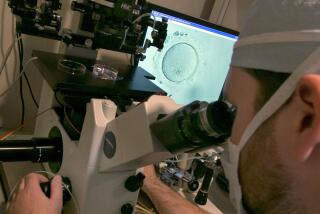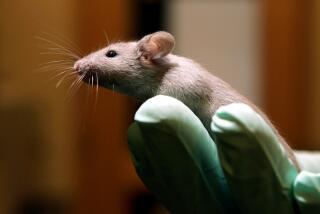Scientists use cloning to make stem cells matched to two adults
Scientists have replicated one of the most significant accomplishments in stem cell research by creating human embryos that were clones of two men.
The lab-engineered embryos were harvested within days and used to create lines of infinitely reproducing embryonic stem cells, which are capable of growing into any type of human tissue.
The work, reported Thursday in the journal Cell Stem Cell, comes 11 months after researchers in Oregon said they had produced the world’s first human embryo clones and used them to make stem cells. Their study, published in Cell, aroused skepticism after critics pointed out multiple errors and duplicated images.
In addition, the entire effort to clone human embryos and then dismantle them in the name of science troubles some people on moral grounds.
MORE: Medicines and machines, inspired by nature
The scientists in Oregon and the authors of the new report acknowledged that the clones they created could develop into babies if implanted in surrogate wombs. But like others in the field, they have said reproductive cloning would be unethical and irresponsible.
The process used to create cloned embryos is called somatic cell nuclear transfer, or SCNT. It involves removing the nucleus from an egg cell and replacing it with a nucleus from a cell of the person to be cloned. The same method was used to create Dolly the sheep in 1996, along with numerous animals from other species.
Human cloning was a particular challenge, in part because scientists had trouble getting enough donor eggs to carry out their experiments. Some scientists said SCNT in humans would be impossible.
Dr. Robert Lanza, the chief scientific officer for Advanced Cell Technology Inc. in Marlborough, Mass., has been working on SCNT off and on for about 15 years. He and his colleagues finally achieved success with a modified version of the recipe used by the Oregon team and skin cells donated by two men who were 35 and 75.
After swapping out the nucleus in the egg cell, both groups used caffeine to delay the onset of cell division — a technique that has been called “the Starbucks effect.” But instead of waiting 30 minutes to prompt cell division, as was done in the Oregon experiment, Lanza and his team waited two hours.
It remains unclear exactly how the egg causes the cells in previously mature tissues — in this case, skin — to transform into a more versatile, pluripotent state.
But Lanza and his colleagues said their experiments revealed that some eggs were better at it than others. Researchers used 49 eggs from three women, though eggs from only two of them produced results.
“The magic is in the egg,” Lanza said.
Experts who were not involved in the experiments said the achievement was significant because it offered clear confirmation that so-called therapeutic cloning is possible with human cells. Given the field’s history of fraudulent claims, such confirmation was valuable, said stem cell researcher Sean Morrison, director of the Children’s Medical Center Research Institute at UT Southwestern.
“This makes it clear that it is possible to succeed,” Morrison said.
In 2005, South Korean researcher Woo Suk Hwang claimed to have created cloned human embryos, but those experiments were later shown to be fabricated.
It took another eight years for cell biologist Shoukhrat Mitalipov to create the first cloned human embryo and resulting stem cells in a laboratory at Oregon Health & Science University.
“My team is very pleased that our results ... are reproducible,” Mitalipov said.
Pluripotent stem cells have become increasingly valuable in medical research. By using them to grow tissue cells involved in diseases, scientists can study them directly rather than relying on mice or other animals as proxies. Scientists are trying to use them to grow replacement tissues for treating diabetes, heart disease and a form of age-related blindness called macular degeneration, among other conditions.
But coaxing normal tissue cells to revert to an embryonic state is challenging. The use of human egg cells complicates the process even further, due in part to their limited availability.
In the years that Lanza spent working on therapeutic cloning, many of his colleagues shifted their focus to a method that uses viruses and other compounds to rewind a cell to an earlier, more flexible state of development. The researcher who first developed these induced pluripotent stem cells, or iPS cells, won a Nobel Prize for the work.
With so much momentum behind iPS cells, it’s unlikely that the new study will prompt many researchers to return their focus to SCNT, said Dr. Arnold Kriegstein, director of the Developmental and Stem Cell Biology Program at UCSF School of Medicine.
“With the iPS technology, almost any molecular biology lab can create stem cell lines using simply skin cells, or even blood cells,” said Kriegstein, who wasn’t involved in the cloning studies.
Lanza said that most stem cell scientists have “jumped on the iPS bandwagon,” but he argued that stem cells created by SCNT could still play a vital role in regenerative medicine.
He envisions a day when multiple lines of stem cells are kept in banks and made available to patients based on their biological similarity, much the way blood and donor organs are now handled.
“If we had these banks, we would have the raw material to do tissue engineering and grow up organs, or to grow up vessels, tendons or whatever you want,” Lanza said.
Twitter: @montemorin







